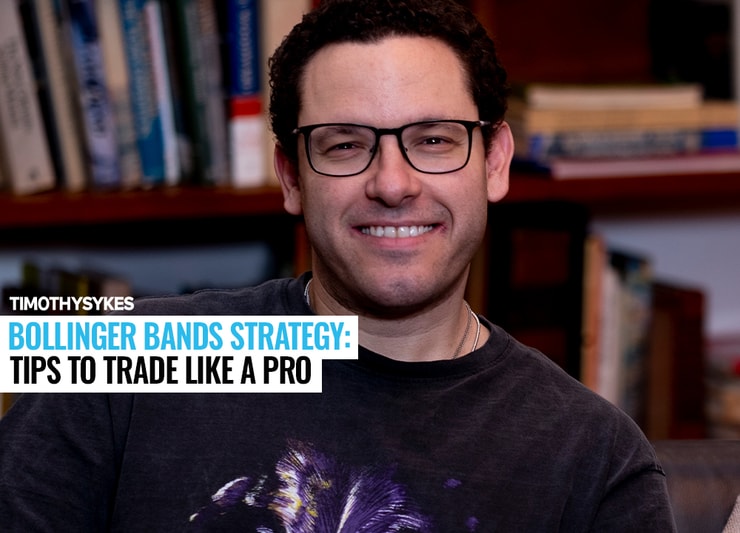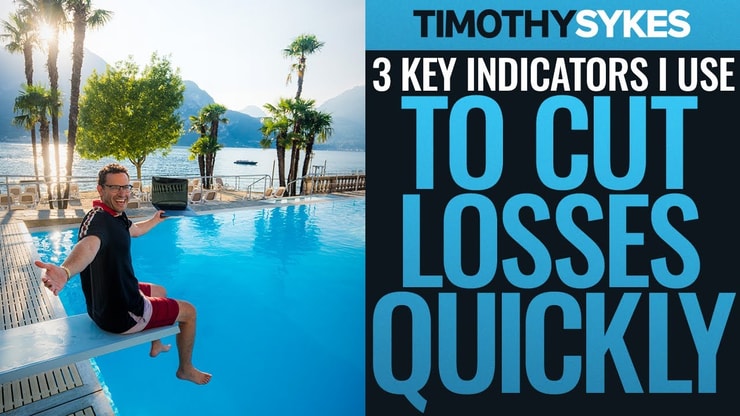Too many traders want to know the best Bollinger Bands strategy…
I get it. You want to make money in the stock market. But this is the wrong attitude.
Let me help clear it up…
There isn’t one simple strategy to follow for consistent profits. If there was, everyone would use it. You’d know long before I posted this.
Stocks can be volatile and dangerous for newbies who don’t know what they’re doing. Indicators — like Bollinger Bands — help traders navigate dangerous conditions when playing a strategy.

Looking at a stock from different angles gives me a better idea of what it might do.
I always pay attention to the same indicators. Over 20+ years of trading, I’ve learned how to use them to keep myself safe.
You should explore every tool you’re given. When I was starting out, I tested a bunch of theories until I found a system that worked best for me.
Don’t short-change your education. Learn how Bollinger Bands work and how traders use them in different strategies. You never know, maybe this post introduces you to a missing puzzle piece.
Table of Contents
- 1 What Is the Bollinger Bands Strategy?
- 2 Understanding How Bollinger Bands Work
- 3 How Can You Use the Bollinger Bands Strategy Effectively?
- 4 What Is the Best Setting for Bollinger Bands?
- 5 Are Bollinger Bands Effective?
- 6 Frequently Asked Questions About Bollinger Bands
- 7 The Bottom Line on the Bollinger Bands Strategy
What Is the Bollinger Bands Strategy?

2025 Millionaire Media, LLCStrategies vary from trader to trader. Some go long, others short. The first green day pattern is one of my favorites. For others, it may be swing trades.
Every strategy relies on a lot of technical analysis. Each tool a trader uses for that analysis has a specific purpose.
The problem is, one by itself is too narrow a mindset. You’ve gotta be able to pay attention to multiple indicators at one time.
Don’t think of it as a Bollinger Bands strategy but a strategy backed up by Bollinger Bands.
Just like my Sykes Sliding Scale. Only using one by itself paints an imperfect picture of the market.
I don’t use Bollinger Bands much when I’m trading because I found other indicators that work well for me. If I pay attention any more I might over-analyze and make a mistake…
A big part of trading is knowing when to not trade.
We might not pay attention to the same indicators or have the same strategies. But it’s important to treat each indicator as smaller parts of a whole.
Don’t fixate on what you think will happen. Let the market show you.
All the strategies I use start with the Sykes Sliding Scale. Once I weigh all the indicators I decide whether to make a trade.
Bollinger Bands can help some traders make more informed decisions. It’s important to explore every tool. After all, trading is like going to war. Those with the best weapons usually win.
Speaking of weapons … I use StocksToTrade as my charting software. It has all the indicators I need to trade and the charts are ultra-clean.*
Let me introduce you to the Bollinger Bands strategy. Then you can choose to use it or not.
Understanding How Bollinger Bands Work
If you want to understand how the Bollinger Band strategy works, you have to understand how Bollinger Bands work.
The key thing to understand is that they measure price and volatility.
They consist of three lines — or bands — calculated from a stock’s price.
The center line is a 20-period moving average of the stock’s price. Most software platforms use the simple moving average or SMA.
That means the line is an average of where the price has been for the last 20 periods. If you were looking at a daily chart, it would be 20 days, an hour chart would be 20 hours, and so on…
The top and bottom lines are usually two standard deviations away from the middle line. Technically you can change the number of standard deviations. You can change the periods of time for the moving average too. But traders most often use the following setting: (20,2).
The standard deviation is a measure of how much the price varies from the average.
This means the middle line measures the price, and the top and bottom measure volatility. As volatility climbs, the top and bottom lines expand to include more of the recent price action.
At two standard deviations, 95% of the stock’s price should trade between the top and bottom lines. But that isn’t always the case. This isn’t an exact science.
But if you know what you’re doing, a combination of imperfect indicators can paint a clear enough picture.
Make sure you learn how to use them and watch what they tell you about the market.
How Can You Use the Bollinger Bands Strategy Effectively?

2025 Millionaire Media, LLCTraders use this strategy to help identify overbought and oversold levels. They can also help find stocks following a trend, and potential breakouts.
But you have to know when to buy and sell.
How to Buy and Sell
The top and bottom lines tend to contain most of the price. So any stock that dips below the channel is oversold. Any stock that perks above is overbought.
But if the stock dips below the lowest line it doesn’t mean it will rebound to a profitable selling price. The stock may ride the line down quite a ways.
The opposite’s also true. It’s common to see breakout plays trade above the top band and continue to climb.
The middle line can help traders tell which way the stock is trending. That hints at which way it might continue to move in the future.
All three lines can help identify stock trends and volatility.
Volatile trends can be hugely profitable for prepared, experienced traders.
Speed up your learning curve and check out my 30-Day Bootcamp. I filmed it with Matt Monaco before he reached $1 million in trading profits.** It’s a great introduction to volatile penny stock trading.
Remember, I’m not giving you the one ring to rule them all. On their own, the indicator and Bollinger Band strategy are worthless and take a lot of work to use correctly.
Keep reading to figure out how, or if, it can help you trade better.
How to “Predict” the Market
I hate using the word predict.
Nothing’s certain in the stock market. Any prediction you make can be wrong at any time. That’s how I approach trading and it’s kept me safe for over two decades.
I trade scared.
But with enough studying and experience, indicators can help you make more informed predictions. They can also help you cut losses quickly, which is my #1 rule.
Traders can identify the stock’s trend using SMA. It helps them make informed predictions on its future direction. The standard deviation lines show you where the stock will most likely trade between.
When the lines are close together the volatility is low. Once they start to widen, that’s a clue that volatility is entering the market. Pay attention.
Here’s CytRx Corporation (OTCQB: CYTR) from June 10. Notice how the bands are close together right before the stock spikes up. Then the SMA line slopes up and the lines widen to show volatility is increasing.

Big thanks to StocksToTrade for that chart.* Very easy on the eyes.
This isn’t the only Bollinger Bands strategy traders use. Start researching to see how patterns form in the market and what other top traders do.
Look at different markets too. Bollinger Bands is widely used throughout the industry.
More Breaking News
- Snap’s AI Concerns: Legal Risks Loom?
- Rekor Systems’ Drop: Time to Reassess?
- Elf Beauty: Analyzing Recent Setbacks
How to Use the Bollinger Bands Strategy in Cryptocurrency
It’s just like any other indicator. Watch how it affects the securities you trade to better understand it.
Crypto tends to be a more volatile market. That means you have to be more careful. It’s especially important to diversify your indicators in volatile markets. Only make the best trades.
Playing it safe is how the top traders stay in the game.
Bollinger Bands Settings for Scalping
I’m not a scalper. I’ll take a small profit every now and then, sure.
The difference is I trade strategies with the potential for a high percentage return. Sometimes the plan doesn’t go as I thought. If that happens, I get out to protect my gains and minimize my losses.
My rule #1 is to cut losses quickly. It’s saved me countless times from losing big.
Scalping is a legitimate strategy for some people. I wouldn’t recommend it … But I won’t rain on anyone’s parade.
Scalpers jump in and out of stocks for a few percentage points. Trading that quickly with only a small chance of profits is too risky for me. Also, it sounds exhausting. You’d have to make so many trades every day for it to be worth it.
Scalped positions are quick. Those traders need more accurate information about the short-term stock price.
Many will choose to decrease the moving period for the SMA. Instead of 20, they might try 15.
The average will use newer data so the indicator will react more quickly to new information. But less data means less accuracy. Sounds like a gamble to me…
And I never gamble. There’s no place for that in the stock market.
But there is a way to increase the accuracy while keeping the same time setting…
Triple Bollinger Bands Strategy
Hold onto your hats. There’s a way to squeeze more data out of this thing.
As if there weren’t enough lines already, this strategy adds another pair. The center line is still the SMA. The top and bottom lines are still two standard deviations from the SMA. But the new pair is one standard deviation above and below it.
Some traders find that this extra pair of lines helps them identify trends. They can also act as the points the stock trades between — like support and resistance lines.
RSI and the Bollinger Bands Strategy
It’s common to see these two together. The relative strength index — or RSI — is a measure of stock momentum. It can help identify overbought and oversold levels.
Sound familiar?
Both of these indicators measure a similar aspect of a stock’s price action.
RSI is always measured between 0–100. An RSI above 70 is overbought and below 30 is oversold.
Checking indicators against each other is great practice. Using a combination will help you better understand the market. Try different combos until you find a system that works for you.
What Is the Best Setting for Bollinger Bands?

2025 Millionaire Media, LLCLike I said — test different theories to find your sweet spot. But don’t get too fixated on any one thing in the process.
Trying to tweak your settings to get them just right can become obsessive. I’d say it’s best to keep things as simple as possible to help you keep a broad outlook.
Most traders say (20,2) is the best setting for the bands.
Sometimes it’s best to go the tried-and-true route. Especially if it keeps things from getting complicated. Switching up settings at random can decrease the effectiveness.
Are Bollinger Bands Effective?
Some traders swear by them and the Bollinger Bands strategy. Others — like me — don’t pay them much attention. The beauty of the tool is that its existence helps us understand the market in a different way.
It might not be a helpful indicator for you. That’s OK. But all data can be useful, and you should explore every opportunity. Use whatever’s helpful to YOU and always study before you trade.
Frequently Asked Questions About Bollinger Bands
Which Indicator Works Best With Bollinger Bands?
Everyone’s different. What works for me might not work for you. But you should always pay attention to more than one indicator. A good start is looking at RSI. A lot of traders use them together.
What Time Frame Is Best for Bollinger Bands?
A common setting is using a 20-period moving average. Traders find that this seems to work best for charts on all time frames. Feel free to switch up the settings but don’t get too fixated.
Can Bollinger Bands Predict Price Moves?
Be careful with the word “predict.” Nothing’s certain in the stock market. But with enough experience and practice, they can give traders an insight as to where the stock might go.
The Bottom Line on the Bollinger Bands Strategy
Chart indicators help traders make well-informed decisions. Notice the word “indicators” — it’s plural. Using one by itself would be account suicide.
Bollinger Bands are no different. They can provide an interesting angle of the market, but they’re not the holy grail.
The market is full of fakeouts and random intense volatility. Using multiple tools can help keep you safer by giving you a clearer picture.
It’s important to try different combinations to find out what works for you.
But no matter whether you use the Bollinger Bands strategy or not, know that successful traders have something in common … They work hard.
Just ask any of my millionaire students.** They all had to study for months, sometimes years before starting to earn a profit.
If you think you’re ready to join their ranks, apply for my Trading Challenge today. My team and I don’t accept everyone, you’ll have to show us you’re willing to do the work.
Start your education on the right track. Just taking the time to learn about this trading tool sets you apart from the pack. Don’t stop now.
What do you think about the Bollinger Bands strategy? Do you use it? Tell me why or why not. I love hearing from you!
Disclaimers
*Tim Sykes is a minority stakeholder in StocksToTrade.com. StocksToTrade Breaking News chat is an add-on subscription to the platform.
**These results are not typical. Individual results will vary. Most traders lose money. Traders like Matt and I have the benefit of many years of hard work and dedication. Trading is inherently risky. Always do your due diligence and never risk more than you can afford to lose. I’ve also hired Matt Monaco to help in my education business.












Leave a reply